 Guest Blogged by John Bonifaz
Guest Blogged by John Bonifaz
Ed Note: John Bonifaz is a constitutional attorney, the founder of the National Voting Rights Institute and a Senior Legal Fellow of Demos' Democracy Program. He further serves as co-counsel for VoterAction.org on behalf of the voter plaintiffs in the Sarasota FL-13 case.
Earlier today, The BRAD BLOG posted a short article about the new Holt Election Reform bill in the U.S. House urging readers to read it before either endorsing or rejecting the legislation. We hope to have a thorough analysis of the bill in the coming days and weeks. For now, Mr. Bonifaz, given his background, credentials and current work on the FL-13 case, provides a useful and important perspective on the new legislation.
Today, Congressman Rush Holt introduced H.R. 811 [PDF], a bill trumpeted as requiring “a voter-verified permanent paper ballot.” But before we all jump on this train as the new guarantee that our votes will be properly counted in future elections, we ought to beware of the warning flag. A paper trail from DRE (Direct Recording Electronic, usually touch-screen) machines cannot protect the integrity of our elections.
Here’s the bottom line: The DRE technology is fundamentally flawed for recording and counting our votes. The Holt bill, unless amended, will further codify into law the use of this technology, piling onto the disaster of HAVA (the Help America Vote Act of 2002) a new disaster.
Florida Governor Charlie Crist recently announced proposed state funding to replace DREs in the state with optical scan machines for election days and Florida is moving forward on certifying the AutoMARK machine, a ballot marking device NOT a direct recording device. New Mexico has already moved away from DREs and has a blended system of optical scan machines and AutoMARK. New York may soon go that way, as may California and Ohio.
Why, in the face of this movement in the states, should we embrace a bill in Congress that allows for the continued use of DREs? Yes, optical scan can also be vulnerable to being hacked, but at least with optical scan, there are still paper ballots (marked by hand or by a ballot marking device) that can be audited or recounted to ensure that our votes are properly counted. DREs provide no such guarantee.
Yes, the Holt bill tries to say it is requiring a paper ballot even for DREs, but, in the end, a DRE "paper ballot" is nothing more than a paper trail, which requires voters to verify their votes after they have cast them in the DRE machines. Studies show that most voters will not spend the time to verify their votes after casting them into DRE machines. Thus, the "voter-verified paper ballot" is a fiction when it comes to DREs.
If none of this is convincing, we need to look no further than Sarasota, the current epicenter of this debate. A "voter-verified" paper ballot or paper trail in Sarasota would not have erased the problem with the 18,000 missing votes in the FL-13 congressional election. With most voters not verifying their votes, most of those missing votes would still be missing --- and with no way to recover them and derive voter intent.
As Brad Friedman rightly says, placing a paper trail on DREs is like placing a seatbelt in the Ford Pinto. The Pinto will still explode --- so what is the point of installing a seatbelt?
We can and we should press for the principled position here: an amendment to the Holt bill that would ban the continued use of DREs and require a real paper ballot. Otherwise, we're going to wake up in 2008 realizing the new disaster we helped to create.


 Sunday 'Great Start!' Toons
Sunday 'Great Start!' Toons Vets Push Back at Trump, Musk Plan to Slash Health Care, 80K V.A. Jobs: 'BradCast' 3/27/25
Vets Push Back at Trump, Musk Plan to Slash Health Care, 80K V.A. Jobs: 'BradCast' 3/27/25 'Green News Report' 3/27/25
'Green News Report' 3/27/25
 Signal Scandal Worsens for Trump, GOP; Big Dem Election Wins in PA: 'BradCast' 3/26
Signal Scandal Worsens for Trump, GOP; Big Dem Election Wins in PA: 'BradCast' 3/26 'Emptywheel' on Why Trump NatSec Team Should 'Resign in Disgrace' After Signal Chat Debacle: 'BradCast' 3/25/25
'Emptywheel' on Why Trump NatSec Team Should 'Resign in Disgrace' After Signal Chat Debacle: 'BradCast' 3/25/25 'Green News Report' 3/25/25
'Green News Report' 3/25/25 USPS 'Belongs to the People, Not the Billionaires': 'BradCast' 3/24/25
USPS 'Belongs to the People, Not the Billionaires': 'BradCast' 3/24/25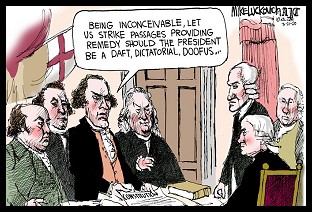 Sunday 'Suddenly Conceivable' Toons
Sunday 'Suddenly Conceivable' Toons 'Green News Report' 3/20/25
'Green News Report' 3/20/25 We're ALL Voice of America Now: 'BradCast' 3/20/25
We're ALL Voice of America Now: 'BradCast' 3/20/25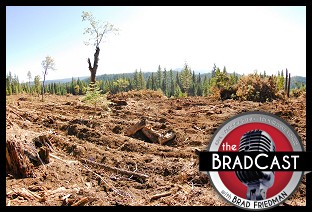 What Trump's 'Timber Production Expansion' Means (and Costs): 'BradCast' 3/19/25
What Trump's 'Timber Production Expansion' Means (and Costs): 'BradCast' 3/19/25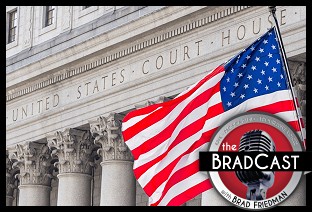 Courts Largely Holding Against Trump, Musk Lawlessness: 'BradCast' 3/18/25
Courts Largely Holding Against Trump, Musk Lawlessness: 'BradCast' 3/18/25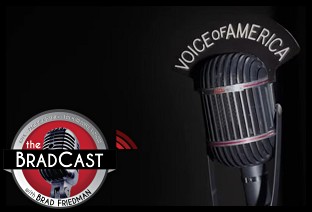 Chief VOA Reporter on Outlet Falling Silent First Time Since 1942: 'BradCast' 3/17/25
Chief VOA Reporter on Outlet Falling Silent First Time Since 1942: 'BradCast' 3/17/25 Trump EPA Unveils Plans to Endanger, Sicken Americans: 'BradCast' 3/13/25
Trump EPA Unveils Plans to Endanger, Sicken Americans: 'BradCast' 3/13/25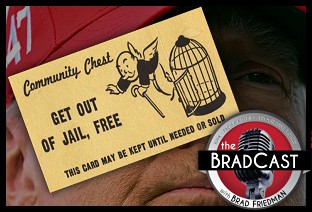 Trump Nixed Enforce-ment Against 100 Corp. Lawbreakers: 'BradCast' 3/12/25
Trump Nixed Enforce-ment Against 100 Corp. Lawbreakers: 'BradCast' 3/12/25 Bad Day for 'Strongmen': 'BradCast' 3/11
Bad Day for 'Strongmen': 'BradCast' 3/11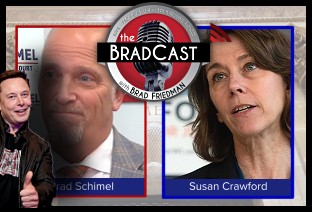 WI Election Could Flip Supreme Court Control, Musk Jumps In: 'BradCast' 3/10
WI Election Could Flip Supreme Court Control, Musk Jumps In: 'BradCast' 3/10
 VA GOP VOTER REG FRAUDSTER OFF HOOK
VA GOP VOTER REG FRAUDSTER OFF HOOK Criminal GOP Voter Registration Fraud Probe Expanding in VA
Criminal GOP Voter Registration Fraud Probe Expanding in VA DOJ PROBE SOUGHT AFTER VA ARREST
DOJ PROBE SOUGHT AFTER VA ARREST Arrest in VA: GOP Voter Reg Scandal Widens
Arrest in VA: GOP Voter Reg Scandal Widens ALL TOGETHER: ROVE, SPROUL, KOCHS, RNC
ALL TOGETHER: ROVE, SPROUL, KOCHS, RNC LATimes: RNC's 'Fired' Sproul Working for Repubs in 'as Many as 30 States'
LATimes: RNC's 'Fired' Sproul Working for Repubs in 'as Many as 30 States' 'Fired' Sproul Group 'Cloned', Still Working for Republicans in At Least 10 States
'Fired' Sproul Group 'Cloned', Still Working for Republicans in At Least 10 States FINALLY: FOX ON GOP REG FRAUD SCANDAL
FINALLY: FOX ON GOP REG FRAUD SCANDAL COLORADO FOLLOWS FLORIDA WITH GOP CRIMINAL INVESTIGATION
COLORADO FOLLOWS FLORIDA WITH GOP CRIMINAL INVESTIGATION CRIMINAL PROBE LAUNCHED INTO GOP VOTER REGISTRATION FRAUD SCANDAL IN FL
CRIMINAL PROBE LAUNCHED INTO GOP VOTER REGISTRATION FRAUD SCANDAL IN FL Brad Breaks PA Photo ID & GOP Registration Fraud Scandal News on Hartmann TV
Brad Breaks PA Photo ID & GOP Registration Fraud Scandal News on Hartmann TV  CAUGHT ON TAPE: COORDINATED NATIONWIDE GOP VOTER REG SCAM
CAUGHT ON TAPE: COORDINATED NATIONWIDE GOP VOTER REG SCAM CRIMINAL ELECTION FRAUD COMPLAINT FILED AGAINST GOP 'FRAUD' FIRM
CRIMINAL ELECTION FRAUD COMPLAINT FILED AGAINST GOP 'FRAUD' FIRM RICK SCOTT GETS ROLLED IN GOP REGISTRATION FRAUD SCANDAL
RICK SCOTT GETS ROLLED IN GOP REGISTRATION FRAUD SCANDAL VIDEO: Brad Breaks GOP Reg Fraud Scandal on Hartmann TV
VIDEO: Brad Breaks GOP Reg Fraud Scandal on Hartmann TV RNC FIRES NATIONAL VOTER REGISTRATION FIRM FOR FRAUD
RNC FIRES NATIONAL VOTER REGISTRATION FIRM FOR FRAUD EXCLUSIVE: Intvw w/ FL Official Who First Discovered GOP Reg Fraud
EXCLUSIVE: Intvw w/ FL Official Who First Discovered GOP Reg Fraud GOP REGISTRATION FRAUD FOUND IN FL
GOP REGISTRATION FRAUD FOUND IN FL

































